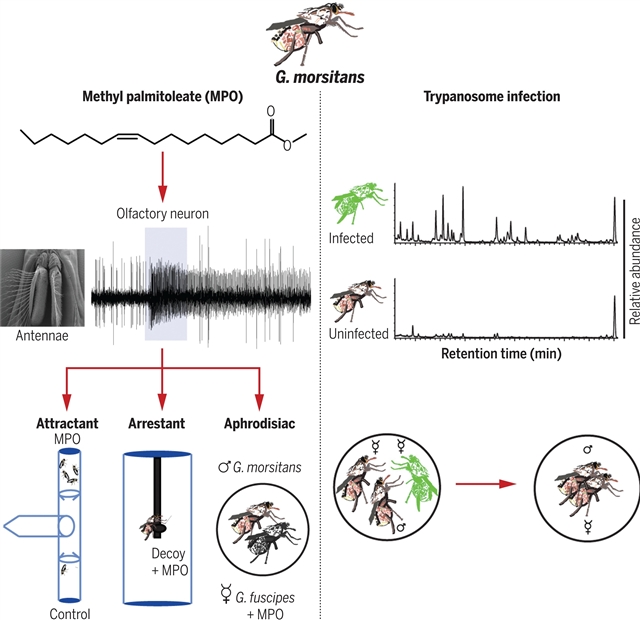
研究人员确定棕榈油酸甲酯(MPO)、油酸甲酯和棕榈酸甲酯是采采蝇Glossina morsitans产生的化合物,并引起强烈的行为反应。MPO引起了雄性的行为反应,但对处女雌虫无用。当用MPO处理时,Glossina morsitans的雄性与另一种Glossina fthemcipes的雌性交配。研究人员进一步在Glossina morsitans中发现了一个嗅觉神经元亚群,该亚群在对MPO的反应中增加了它们的放电速率,并表明用非洲锥虫感染果蝇会改变果蝇的化学特征和交配行为。在采采蝇中鉴定挥发性引诱剂对减少疾病传播具有重要意义。
据悉,采采蝇在撒哈拉以南非洲的大部分地区传播锥虫——一种在人类和牲畜中引起毁灭性疾病的寄生虫。通过挥发性信息素进行化学交流在昆虫中很常见;然而,目前尚不清楚采采蝇是否以及如何发生这种化学交流。
附:英文原文
Title: A volatile sex attractant of tsetse flies
Author: Shimaa A. M. Ebrahim, Hany K. M. Dweck, Brian L. Weiss, John R. Carlson
Issue&Volume: 2023-02-17
Abstract: Tsetse flies transmit trypanosomes—parasites that cause devastating diseases in humans and livestock—across much of sub-Saharan Africa. Chemical communication through volatile pheromones is common among insects; however, it remains unknown if and how such chemical communication occurs in tsetse flies. We identified methyl palmitoleate (MPO), methyl oleate, and methyl palmitate as compounds that are produced by the tsetse fly Glossina morsitans and elicit strong behavioral responses. MPO evoked a behavioral response in male—but not virgin female—G. morsitans. G. morsitans males mounted females of another species, Glossina fuscipes, when they were treated with MPO. We further identified a subpopulation of olfactory neurons in G. morsitans that increase their firing rate in response to MPO and showed that infecting flies with African trypanosomes alters the flies’ chemical profile and mating behavior. The identification of volatile attractants in tsetse flies may be useful for reducing disease spread.
DOI: ade1877
Source: https://www.science.org/doi/10.1126/science.ade1877
